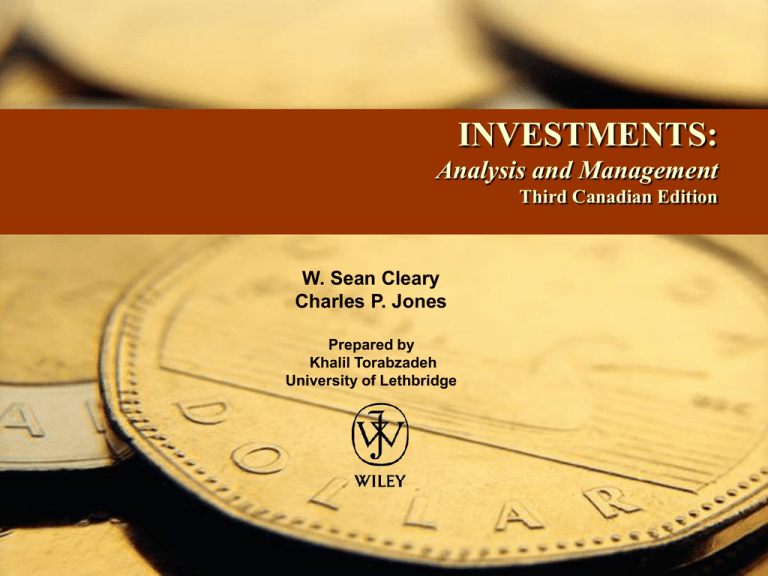
INVESTMENTS:
Analysis and Management
Third Canadian Edition
W. Sean Cleary
Charles P. Jones
Prepared by
Khalil Torabzadeh
University of Lethbridge
Chapter 5
How Securities Are Traded
Learning Objectives
• Explain the role of brokerage firms and
stockbrokers.
• Describe how brokerage firms operate.
• Outline how orders to buy and sell securities are
executed.
• Discuss the regulation of the Canadian securities
industry.
• Explain the importance of margin trading and
short selling to investors.
Cleary Jones/Investments: Analysis and Management, 3rd Canadian Edition, Chapter 5
Brokerage Transactions
• Brokerage firms earn commissions on executed
trades, sales loads on mutual funds, profits from
securities sold from inventory, underwriting fees
and administrative account fees
• Full-service brokers offer order execution,
information on markets and firms, and investment
advice
• Discount brokers offer order execution
Cleary Jones/Investments: Analysis and Management, 3rd Canadian Edition, Chapter 5
Types of Brokerage Accounts
• Cash account: Investor pays 100% of
purchase price for securities
• Margin account: Investor borrows part of the
purchase price from the broker
• Wrap account: Brokers match investors with
outside money managers; all costs are
wrapped in one fee
Cleary Jones/Investments: Analysis and Management, 3rd Canadian Edition, Chapter 5
Fees and Costs
• Brokerage commissions differ by security,
broker, and investor
Institutional investors have greatest negotiating
power
On-line trading offers significantly lower
commission rates to individual investors
•
In 1992 E*TRADE became the first brokerage
service to offer on-line trading
• Dividend reinvestment plans (DRIPs) permit
reinvestment of dividends in additional stock
Cleary Jones/Investments: Analysis and Management, 3rd Canadian Edition, Chapter 5
Orders on Organized Exchanges
• The TSX introduced the world’s first computerassisted trading system (CATS) in 1977
• The NYSE continues to make use of the
specialist system
Specialists maintain the limit order book
Specialists keep a fair and orderly market by
providing liquidity
Cleary Jones/Investments: Analysis and Management, 3rd Canadian Edition, Chapter 5
Orders in OTC Markets
• Dealers are ready to either buy or sell
Bid price is the highest offer price to buy
Ask price is the lowest price willing to sell
•
Ask price - Bid price >0 (dealer spread)
Dealer “makes a market” in the security
More than one dealer for each security in overthe-counter markets
Cleary Jones/Investments: Analysis and Management, 3rd Canadian Edition, Chapter 5
Types of Orders
• Market order: Authorizes immediate
transaction at best available price
• Limit order: Specifies a particular market price
before a transaction is authorized
• Stop order: Specifies a particular market price
at which a market order is authorized
Cleary Jones/Investments: Analysis and Management, 3rd Canadian Edition, Chapter 5
Clearing Procedures
• Settlement dates for stocks are three
business days after the trade date
Legal ownership transferred and financial
arrangements settled with brokerage firm
• Transfer of securities and funds between
exchange members facilitated by a
clearinghouse: The Canadian Depository for
Securities (CDS)
Cleary Jones/Investments: Analysis and Management, 3rd Canadian Edition, Chapter 5
Canadian Regulatory Environment
• Self-Regulatory Organizations (SROs) regulate
their own activities
• Canadian Investor Protection Fund (CIPF) was
established to protect investors
• Investment Dealers Association of Canada (IDA)
is the national trade association for the
investment industry
• Canadian Securities Institute (CSI) is the national
education body of the Canadian securities
industry
Cleary Jones/Investments: Analysis and Management, 3rd Canadian Edition, Chapter 5
Margin Accounts
• Exchanges set minimum required deposits of
cash or securities
• Investor pays part of investment cost,
borrows remainder from broker
Margin is the part of the total value of
securities that must be deposited with the
broker to initiate the transaction with the other
part being borrowed from the broker
• Margin call occurs when the actual margin
declines below the margin requirement
Cleary Jones/Investments: Analysis and Management, 3rd Canadian Edition, Chapter 5
Short Sales
• Investor borrows stock from a third party
• Borrowed security sold in open market, to be
repurchased later at an expected price lower
than sale price
Investor liable for declared dividends
Short sale proceeds held by broker
Investor responsible for borrowed shares
Cleary Jones/Investments: Analysis and Management, 3rd Canadian Edition, Chapter 5
Appendix 5A: Trading on the NYSE
• Centralized continuous
auction market
• Exchange participants:
single specialist
commission brokers
independent floor
brokers
registered traders
• SuperDot
• Major roles of NYSE
specialist
Dealer
Agent
Catalyst
Auctioneer
• Commissions
deregulated in 1975
Cleary Jones/Investments: Analysis and Management, 3rd Canadian Edition, Chapter 5
Appendix 5B: U.S. Securities Regulation
• The Securities and Exchange Commission (SEC)
was created by the U.S. Congress in 1934
An independent and quasi-judicial agency of the US
government
• SEC is required to investigate complaints of
violations in securities transactions
• Investment advisor and companies must register
with the SEC and disclose certain information
• Financial Industry Regulatory Authority (FINRA),
formed in 2007, is the largest non-governmental
regulator for securities firms in the U.S.
Cleary Jones/Investments: Analysis and Management, 3rd Canadian Edition, Chapter 5
Copyright
Copyright © 2009 John Wiley & Sons Canada, Ltd. All rights
reserved. Reproduction or translation of this work beyond that
permitted by Access Copyright (The Canadian Copyright
Licensing Agency) is unlawful. Requests for further information
should be addressed to the Permissions Department, John Wiley
& Sons Canada, Ltd. The purchaser may make back-up copies
for his or her own use only and not for distribution or resale. The
author and the publisher assume no responsibility for errors,
omissions, or damages caused by the use of these programs or
from the use of the information contained herein.







